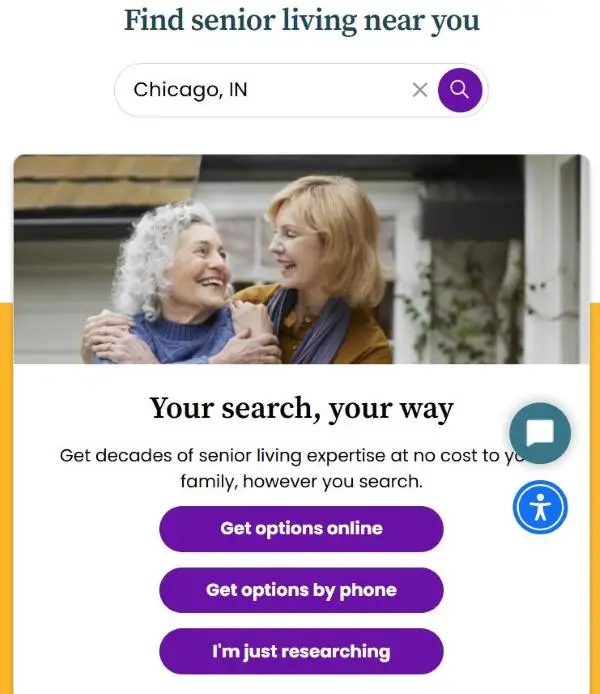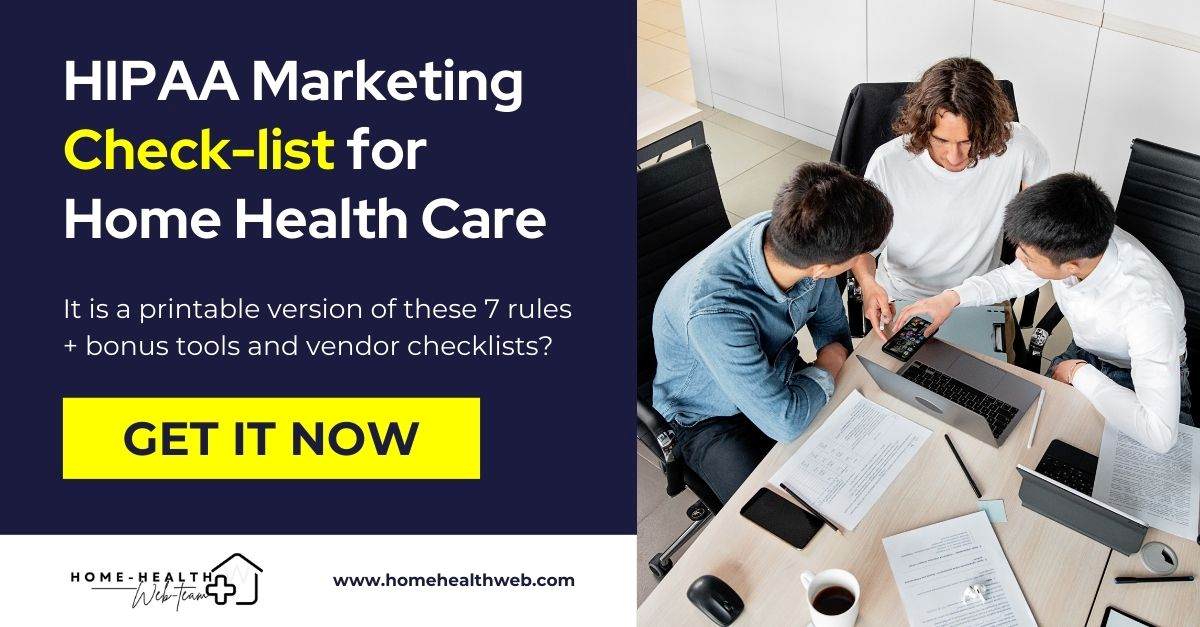TL;DR
Marketing your home health agency in 2025? You must protect patient privacy every step of the way. This guide reveals 7 top marketing strategies to help home health providers generate leads without risking fines or losing family trust, while adhering to HIPAA-compliant marketing rules. From encrypted forms to safe retargeting, these rules help you grow securely, ethically, and effectively.
Key Highlights
- HIPAA marketing violations can cost up to $50,000 per incident
- Encrypted lead forms and HIPAA-safe CRMs are mandatory
- Tools like Google Analytics and Meta Pixel can violate HIPAA
- Retargeting is risky, unless you follow non-PHI pathways
- Business Associate Agreements (BAAs) are not optional
- Web design, CTAs, and language must support patient clarity
- Partnering with a HIPAA-savvy agency is the safest path to scale

Table of Contents
ToggleWhy This Guide Matters in 2025
In today’s AI-driven, privacy-conscious marketing world, trust is your most valuable currency. And nothing erodes trust faster than a HIPAA violation, even an unintentional one. A misplaced tracking pixel, an unsecured form, or a poorly worded call-to-action can put your agency at risk of fines, lawsuits, and public scrutiny.
Yet, families still turn to search engines first when seeking care. Which means your agency needs visibility online, without compromising privacy.
This guide was created specifically for home health agency owners and marketers who want to do both: grow online and adhere to HIPAA-compliant marketing rules.
We bring years of experience implementing HIPAA-safe strategies for care providers across North America, backed by:
- Partnerships with HIPAA-trained developers and platforms
- Ongoing review of HHS HIPAA Marketing Guidelines
- Real-world implementation of The Compassionate LocalCare Marketing System for ethical, local-first patient growth
Stat to Know: Over 82% of patients say they would switch providers over a data privacy concern (source: Cisco Consumer Privacy Survey).
So let’s future-proof your marketing, with compassion, compliance, and confidence.
Why HIPAA-Compliant Marketing Rules Matter More Than Ever
It only takes one mistake. One unsecured contact form. One misplaced email campaign. One tracking pixel on a service page.
That’s all it takes to expose Protected Health Information (PHI) and incur steep HIPAA violations, fines that can reach $50,000 per incident.
But beyond the financial risks, there’s something even more critical at stake: the trust of the families you serve. Every click, form, or ad interaction must protect that trust.
How Today’s Digital Landscape Has Increased HIPAA Marketing Risks
In years past, HIPAA enforcement focused primarily on clinical and administrative violations. Today, marketing technologies have come under serious scrutiny. In 2023, the HHS issued a bulletin clarifying that tracking technologies on healthcare websites (like Meta Pixel and Google Analytics) can violate HIPAA if they collect PHI without explicit patient authorization.
This means that even seemingly benign digital activities like embedding a contact form or tracking which service page a visitor viewed, can create compliance risks if not properly secured and anonymized.
For home health care agencies that rely heavily on digital lead generation, this shift has profound implications. Any system collecting or processing data tied to patient conditions, interests, or geographic targeting can potentially expose PHI, as outlined in HHS PHI classification and privacy rules.
Common Triggers for HIPAA Violations in Marketing
Here are a few real-world examples of how marketing missteps trigger HIPAA violations:
- Contact Forms Without Encryption: Forms collecting names, emails, or treatment interests that lack SSL protection or are connected to non-HIPAA CRMs.
- Retargeting Ads from Sensitive Pages: A user visits a “Hospice Care” page and is later shown ads, this implies a condition and could be deemed PHI exposure.
- Analytics Without De-Identification: Using Google Analytics or Meta Pixel on pages like “Stroke Rehabilitation” can create traceable digital fingerprints, an issue highlighted in OCR HIPAA Violation Case Examples.
- Lack of Business Associate Agreements (BAAs): If your call tracking or chat provider handles PHI and hasn’t signed a BAA, your agency is liable for any data misuse.
These risks are growing as more agencies adopt sophisticated martech stacks. That’s why understanding and implementing HIPAA-compliant marketing rules and practices isn’t just smart, it’s essential for sustainable, trusted growth.
1. Never Collect PHI Without Encryption
What counts as PHI? Any data that can reasonably identify a patient, like name, email, medical condition, or even the fact that they visited a specific service page.
If you’re capturing leads through forms, live chat, or phone call tracking, encryption is non-negotiable. Your forms must use:
- SSL (Secure Socket Layer) to encrypt form data in transit.
- HIPAA-compliant form builders (e.g., Jotform HIPAA, Formstack with BAA).
- Secure CRMs that offer signed Business Associate Agreements (BAAs).
Quick Check: Is your “Request a Consultation” form encrypted and hosted on a HIPAA-compliant platform?
2. Use HIPAA-Compliant Analytics Tools
Traditional platforms like Google Analytics and Meta Pixel can inadvertently collect PHI, especially if they track behavior on service-specific pages (e.g., “Wound Care in Houston”).
To stay compliant:
- Use tools that sign a BAA and offer data anonymization.
- Consider HIPAA-safe platforms like Freshpaint, Plausible Analytics, or Matomo with proper configurations.
- Avoid sharing behavioral data with third parties unless HIPAA compliance is explicitly documented.

For more context on how new technology like AI is transforming compliance in marketing, check out our post on AI Search & the Future of Home Health Care Marketing.
You can also check this out the HHS Marketing Guidance.
3. Require Business Associate Agreements (BAAs)
Every vendor who has access to PHI whether it’s a call tracking tool, CRM, or live chat platform, must sign a Business Associate Agreement (BAA).
BAAs legally bind vendors to HIPAA standards and ensure they handle patient data securely.
Ask vendors:
- “Do you offer a signed BAA?”
- “How do you store and transmit PHI?”
- “Can you show your HIPAA compliance documentation?”
A missing BAA could turn your trusted vendor into a compliance liability.
If you’re evaluating potential vendors, see our guide on How to Choose the Right Lead Generation Partner for Your Home Health Care Business for critical questions to ask.
Get The HIPAA Marketing Checklist & Tools Now
Grab our free HIPAA-Compliant Marketing Guide to safeguard your Home Health Business while you grow.
As a companion to our HIPAA Marketing Checklist, We have included our recommended HIPAA-safe tools your agency can explore for secure growth.
4. Avoid Retargeting Ads That Track PHI
It’s tempting to use retargeting ads that follow visitors who viewed your “Hospice Services” or “Dementia Care” pages. But that targeting reveals sensitive health intent a major HIPAA violation.
Safer alternatives include:
- Interest-based audiences that don’t rely on PHI behavior.
- Lookalike audiences built from first-party data (with consent).
- Retargeting based on non-PHI pages like your homepage or blog articles.
For compliant visibility that doesn’t risk violations, our Local SEO Optimization service is a high-trust alternative.
Do NOT retarget someone just because they viewed a “Stroke Recovery” page.
5. Train Your Team on Marketing & HIPAA
Even the best systems fail if your people don’t understand them.
Your marketing, intake, and IT teams should receive regular training on:
- What qualifies as PHI.
- How to vet third-party tools.
- Secure lead handling procedures.
- What can and cannot be used in testimonials or case studies.
Consider creating a “HIPAA Marketing Playbook” your entire team can reference.
6. Use Secure, Clear Language in CTAs
CTAs like “Schedule an Appointment Now” might sound great, but where do they lead?
If they point to an insecure form or generic email, you’ve just triggered a compliance red flag.
Instead, use:
- Language like “Request a Secure Consultation”
- Clear notes about encryption and privacy
- Verified contact forms with visible SSL indicators
For more insights on how web design impacts trust and patient engagement, explore 10 Reasons Accessible Home Care Website Design Boosts Patient Acquisition.
Trust starts with transparency.

7. Partner With a HIPAA-Savvy Marketing Agency
Many digital marketing firms promise leads and visibility—but few understand the healthcare space.
At Home Health Web, our Compassionate LocalCare Marketing System is designed to blend growth-focused strategy with HIPAA-conscious execution.
We help agencies:
- Dominate local SEO without risking compliance
- Use secure, patient-first messaging
- Implement compliant retargeting, analytics, and form capture
- Earn patient trust at every touchpoint
Final Thoughts: Compliance Is a Growth Strategy
HIPAA compliance isn’t a barrier to marketing success. It’s a foundation for it.
Families choose providers they trust. And trust starts with respecting privacy, communicating clearly, and showing up when and where they need you most.
Build your marketing the right way, with compassion, clarity, and compliance.
Let’s review your current marketing for HIPAA risks, free and confidential.




